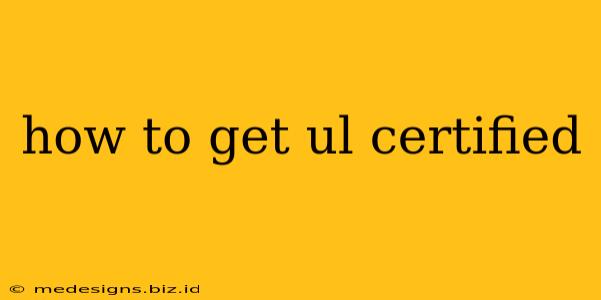Getting your products UL certified is crucial for establishing trust with consumers and meeting safety regulations. UL (Underwriters Laboratories) is a globally recognized independent safety science company, and their certification signifies that your product has met rigorous safety standards. This guide will walk you through the process, helping you navigate the complexities and ensure a smooth certification journey.
Understanding UL Certification
Before diving into the process, it's vital to understand what UL certification entails. It's not a single certification but rather a range of certifications depending on the product and its intended use. UL tests products against specific safety standards, ensuring they meet the required performance and safety criteria. A successful certification demonstrates your commitment to safety and quality, enhancing your brand reputation and opening doors to wider markets.
Why is UL Certification Important?
- Consumer Trust: UL's reputation for rigorous testing instills confidence in consumers, making them more likely to purchase your products.
- Market Access: Many retailers and government agencies require UL certification before allowing products to be sold.
- Liability Protection: Certification provides a degree of legal protection against liability claims related to product safety.
- Competitive Advantage: UL certification differentiates your products from competitors, highlighting their safety and reliability.
Steps to Get UL Certified
The process for obtaining UL certification can vary depending on your product's complexity and the specific standards it must meet. However, the general steps are as follows:
1. Identify Applicable Standards:
The first step involves determining which UL standards are relevant to your product. UL's website provides a comprehensive database of standards. Thoroughly research the appropriate standards to ensure compliance. Incorrectly identifying the standards can delay the process and potentially lead to rejection.
2. Prepare Your Documentation:
You'll need to prepare a comprehensive set of documentation, including:
- Product specifications: Detailed drawings, schematics, and descriptions of your product's components and functionality.
- Manufacturing process documentation: A clear outline of how your product is manufactured.
- Test plans: A detailed plan outlining how you will test your product to meet the relevant UL standards.
3. Choose a Testing Laboratory:
You can choose to have your product tested by a UL-recognized testing laboratory or conduct the testing yourself if you possess the necessary facilities and expertise. Remember that UL must approve your chosen laboratory.
4. Testing and Evaluation:
The testing process will involve rigorous evaluations of your product's safety features and performance. This may include electrical testing, fire testing, and mechanical testing. Closely collaborate with the testing laboratory to address any issues that arise during testing. Prepare for potential revisions to your product design based on testing results.
5. Certification and Listing:
Once your product successfully passes all the required tests, UL will issue a certification. This typically includes a UL listing mark that can be displayed on your product and its packaging. You must also comply with UL's ongoing surveillance requirements to maintain your certification.
Maintaining UL Certification
Maintaining your UL certification requires continuous compliance with the standards and ongoing surveillance. UL may conduct periodic inspections and audits to ensure your product continues to meet the required safety standards.
Choosing the Right Approach
You can choose between a variety of different UL Certification programs, including:
- Complete Certification: This involves testing your entire product to meet all relevant standards.
- Component Certification: This might be appropriate for individual components of a larger product, reducing overall costs.
- Follow-Up Services: UL offers services to help maintain compliance and troubleshoot issues after initial certification.
Carefully evaluate your specific needs and budget to select the most cost-effective and efficient approach for your situation.
Conclusion: Embarking on the Path to UL Certification
Obtaining UL certification can be a complex process, but the benefits are significant. By following these steps and understanding the requirements, you can navigate the process effectively and gain a competitive edge in the marketplace. Remember that proactive planning and close collaboration with a testing laboratory are crucial to ensure a smooth and successful certification process. Prioritize building a strong understanding of the relevant standards and regulations to successfully achieve your goal.
